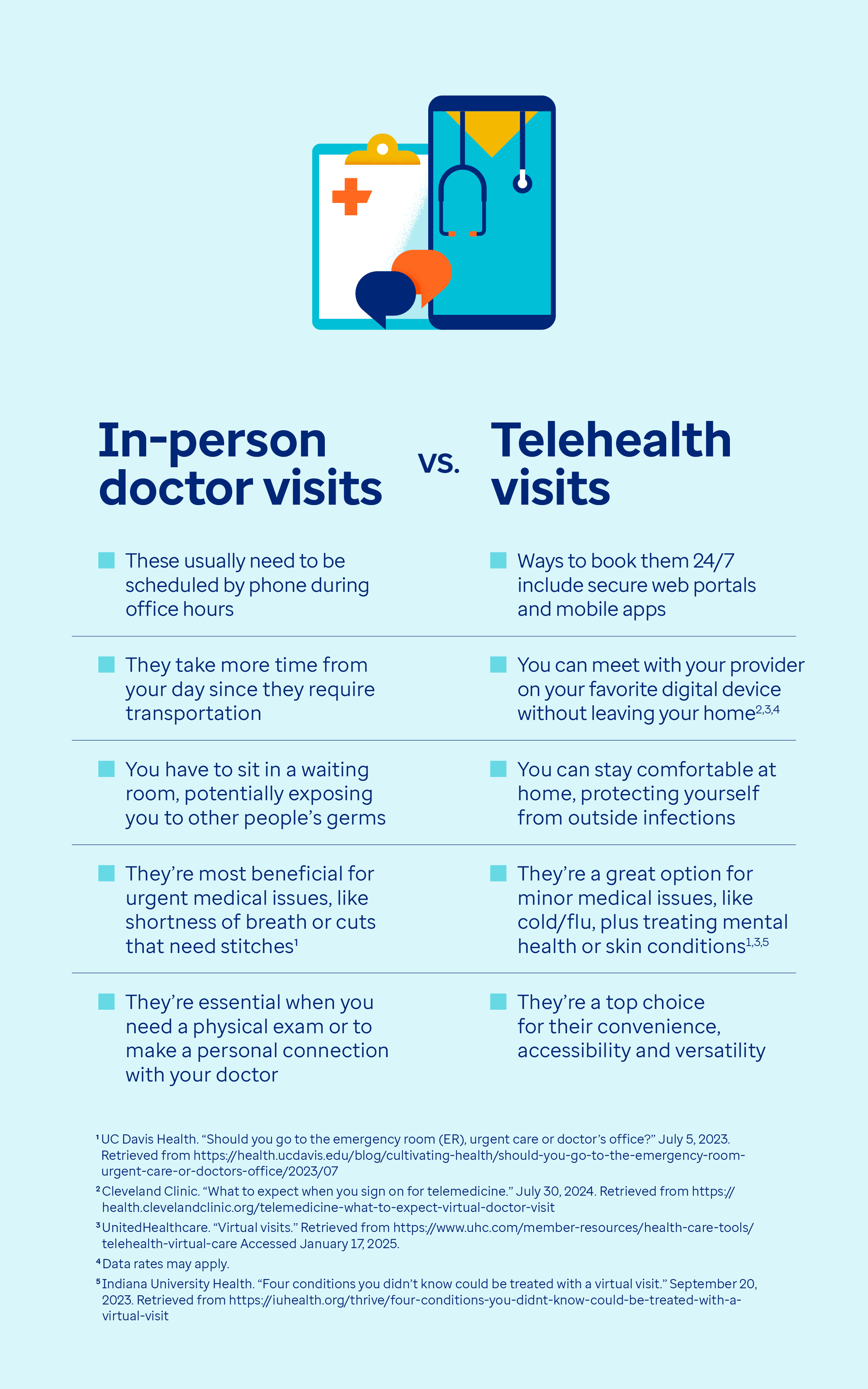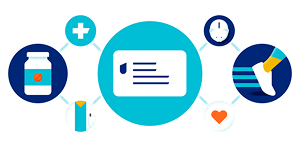- What are telehealth and virtual care?
- What kind of care can I receive virtually?
- How does a virtual visit work?
- What is remote patient monitoring?
- What should I do to prepare for a virtual visit?
- What are the advantages of telehealth?
- What are the disadvantages of telehealth?
- Does my insurance cover telehealth?
Remember how new chatting with your doctor via a phone call or video call seemed a few years ago? Telehealth has actually been around for decades, but for most of that time, it accounted for less than 1% of health care visits.
That all started to change in early 2020 when there was limited access to health care facilities (and practically everything else) around the country. During that period, up to 80% of doctor visits were conducted virtually, in some locations.
While the number of virtual visits leveled off to about 25% in 2022, telehealth is here to stay. “Patients love the ease and convenience of telehealth,” says Lyle Berkowitz, M.D., CEO of KeyCare, an Epic-based virtual care platform.
Read on to learn more about telehealth and virtual visits and how they can benefit you.
If you’re ready to learn more about our HealthiestYou telehealth plan, you can see exactly what’s covered and what your cost will be. Hint: Coverage for general medicine, behavioral health and dermatology is included.
Simply put, telehealth (or telemedicine) is the use of technology to allow you to be treated by a health care provider without going into their office. The visit is mostly conducted online via computers, tablets and smartphones.
“The virtual visit aims to replicate an in-person doctor’s visit while providing convenient, accessible and personalized care to patients from the comfort of their own homes,” says Brad Younggren, M.D. He is chief medical officer and president of care innovation for virtual care platform 98point6 Technologies.
And virtual health is not limited to telemedicine, explains Dr. Younggren. It also includes services like:
- Health education
- Mobile health applications
- Remote patient monitoring
- Wearable devices
- Wellness programs
There is a wide range of health care services that can be done virtually, says Dr. Younggren. That can include having a consultation, discussing your symptoms, reviewing test results and getting recommendations for treatment. According to Dr. Younggren, you can even have a virtual follow-up to an in-person visit to talk about how you are feeling, get changes to medication you may need and address other concerns.
In the past, according to Dr. Berkowitz, telehealth was generally used for diagnosing and treating more minor, routine urgent medical issues, such as:
- Allergies
- Back pain
- Bites or stings
- Burns (minor)
- Colds
- Constipation
- Coughs
- Fevers
- Flus
- Headaches
- Nausea
- Pink eye
- Sinus issues
- Sore throats
- Vomiting
But telehealth isn’t just limited to your physical health. You can also receive help with behavioral and mental health issues. Meeting with a psychologist or psychiatrist from the comfort of your own home can reduce anxiety and embarrassment you might feel when visiting their office.

To set up a virtual visit, you usually request an appointment through the web portal or mobile app of your provider or insurance company. At the scheduled time, you can join through a secure videoconferencing platform or messaging platform.
From there, the visit will likely be similar to an in-person visit with a health care provider.
“They will review patients’ allergies and medications and pertinent medical history, and then ask questions about the current issue,” Dr. Berkowitz explains. “They will then give patients their advice, prescribe medications and send appropriate health education.”
When you have your visit as a video chat, your provider can easily look at your eye infection or that unusual rash; otherwise, you can send photos to them. Though your provider may not be able to do some things, such as take your blood pressure or send you down the hall for a blood draw, there are workarounds.
If needed, your provider can send you to a third-party lab, just as they might do for an in-person visit.
“Once the lab completes the tests and returns them to the provider, they can review the results with the patient during a follow-up telehealth appointment,” Dr. Younggren says, “discussing any findings, providing explanations and determining appropriate next steps.”
An important part of virtual health is remote patient monitoring, which lets your provider keep track of your condition between visits. It is done by using wearable devices or home monitoring equipment to measure vital signs, such as blood pressure, heart rate and blood sugar (glucose) levels.
“The collected data is then securely transmitted to health care providers,” Dr. Younggren explains, “who remotely monitor and analyze the information.”
Ready to explore insurance plans where you live?
As with in-person visits, jot down any questions you want to ask, make sure your list of medications is current, and update it if needed. Also, have your insurance card nearby. You may want to find a quiet, private area for the visit — some place that is comfortable and has good lighting.
Finally, get your technology ready:
- Check your internet connection or wireless signal.
- Test your audio and video before the virtual visit starts.
- Be sure the device you’re using is fully charged or plugged in.
- Sit back, relax and wait for the visit to start.
If you’re used to working remotely, or if your kids have done virtual learning, the tech details will probably be familiar. Otherwise, give yourself a little extra time beforehand to get set up.
Want easy access to virtual visits? Learn more about our telehealth membership.
The most obvious advantage of telehealth is convenience. You don’t have to travel to a provider’s office, find a place to park or spend time in a waiting room. (You might need to spend time in a virtual waiting room, but you can do something productive — such as work, read or fold laundry — while you wait.)
Another benefit is that virtual care is often available 24/7. You don’t have to miss work or school for a routine appointment. And it may help you avoid a trip to an urgent care center.
Telehealth also gives you access to services that may not be available in your community. For example, 163 million Americans live in areas with a shortage of mental health professionals, and even when a provider is available, you can wait weeks or months for an appointment.
Telehealth can also be less expensive. In fact, some insurance companies may offer virtual visits at no additional cost. “The cost to a patient can be lower due to decreased travel costs and time off from work,” explains Dr. Berkowitz.
It also can reduce visits to the emergency room and admissions to the hospital, says Dr. Berkowitz. And it helps with the preventive health care gap, which is when people do not get the recommended screenings, such as for breast cancer or high blood pressure, for common chronic conditions.
Finally, technology can speed up and improve care.











